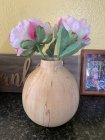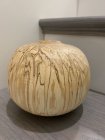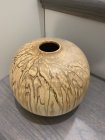John Jordan gave me some great advice when he told me “you need a faceplate” I bought two new faceplates and haven’t looked back. Now that I have been using them, I have a few questions.
What method is used for parting off the finished piece? I’ve been using the parting tool and trying to catch the piece once it is separated from the waste wood. It seems like maybe a better way exists, or maybe a variation of this method.
Is there a trick or tip to get the bottom of the vessel to not look like it just goes flat? Should the bottom or flat part be the same size as the opening?
Thanks in advance, I’m including my two recent turnings that were done with a faceplate for critique.




What method is used for parting off the finished piece? I’ve been using the parting tool and trying to catch the piece once it is separated from the waste wood. It seems like maybe a better way exists, or maybe a variation of this method.
Is there a trick or tip to get the bottom of the vessel to not look like it just goes flat? Should the bottom or flat part be the same size as the opening?
Thanks in advance, I’m including my two recent turnings that were done with a faceplate for critique.





